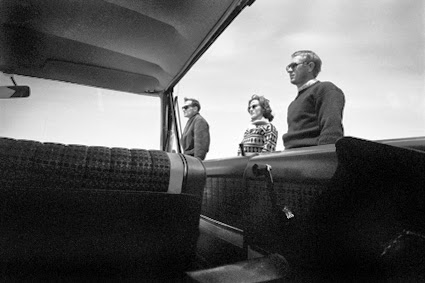Date of Birth
24 March 1930 , Beech Grove, Indiana, USA
Date of Death
7 November 1980 , Ciudad Juárez, Chihuahua, Mexico (heart attack following surgery)
5' 8" (1,73 m)
He was the ultra-cool male film star of the 1960s, and rose from a
troubled youth spent in reform schools to being the world's most popular
actor. Over 25 years after his untimely death from mesothelioma in
1980, Steve McQueen is still considered hip and cool, and he endures as
an icon of popular culture...
His first lead role was in the low-budget sci-fi film La masa devoradora (1958), quickly followed by roles in Asalto al banco de St. Louis (1959) and Cuando hierve la sangre (1959). The young McQueen appeared as Vin, alongside Yul Brynner, in the star-laden Los siete magníficos
(1960) and effectively hijacked the lead from the bigger star by
ensuring he was nearly always doing something in every shot he and
Brynner were in together, such as adjusting his hat or gun belt. He next
scored with audiences with two interesting performances, first in the
WWII drama Comando (1962) and then in El amante de la muerte
(1962). Riding a wave of popularity, McQueen delivered another crowd
pleaser as Hilts, the Cooler King, in the knockout WWII POW film La gran evasión
(1963), featuring his famous leap over the barbed wire on a motorcycle
while being pursued by Nazi troops (in fact, however, the stunt was
actually performed by his good friend, stunt rider Bud Ekins).
McQueen next appeared in several films of mixed quality, including Compañeros de armas y puñetazos (1963); Amores con un extraño (1963) and La última tentativa (1965). However, they failed to really grab audience attention, but his role as Eric Stoner in El rey del juego (1965), alongside screen legend Edward G. Robinson and Karl Malden, had movie fans filling theaters again to see the ice-cool McQueen they loved. He was back in another western, Nevada Smith
(1966), again with Malden, and then he gave what many consider to be
his finest dramatic performance as loner US Navy sailor Jake Holman in
the superb El Yang-Tsé en llamas (1966). McQueen was genuine hot property and next appeared with Faye Dunaway in the provocative crime drama El caso de Thomas Crown (1968), next in what many consider his signature role, that of a maverick, taciturn detective in the mega-hit Bullit
(1968), renowned for its famous chase sequence through San Francisco
between McQueen's Ford Mustang and the killer's black Dodge Charger.
Interestingly,
McQueen's next role was a total departure from the action genre, as he
played Southerner Boon Hogganbeck in the family-oriented Los rateros (1969), based on the popular William Faulkner
novel. Not surprisingly, the film didn't go over particularly well with
audiences, even though it was an entertaining and well made production,
and McQueen showed an interesting comedic side of his acting talents.
He returned to more familiar territory in 1971, with the race film Las 24 horas de Le Mans
(1971), a rather self-indulgent exercise, and its slow plot line
contributed to its rather poor performance in theaters. It wasn't until
many years later that it became something of a cult film, primarily
because of the footage of Porsche 917s roaring around race tracks in
France. McQueen then teamed up with maverick Hollywood director Sam Peckinpah to star in the modern western Junior Bonner (1972), about a family of rodeo riders, and again with Peckinpah as bank robber Doc McCoy in the violent La huida (1972). Both did good business at the box office. McQueen's next role was a refreshing surprise and Papillon (1973), based on the Henri Charrière
novel of the same name, was well received by fans and critics alike. He
plays a convict on a French penal colony in South America who persists
in trying to escape from his captors and feels their wrath when his
attempts fail.
The 1970s is a decade remembered for a slew of "disaster" movies and McQueen starred in arguably the biggest of the time, El coloso en llamas (1974). He shared equal top billing with Paul Newman and an impressive line-up of co-stars including Fred Astaire, Robert Vaughn and Faye Dunaway.
McQueen does not appear until roughly halfway into the film as San
Francisco fire chief Mike O'Halloran, battling to extinguish an inferno
in a 138-story skyscraper. The film was a monster hit and set the
benchmark for other disaster movies that followed. It was, however,
McQueen's last film role for several years, as he began a long fight
against cancer, often resorting to offbeat therapies in an attempt to
beat the disease. After a four-year hiatus he surprised fans, and was
almost unrecognizable under long hair and a beard, as a rabble-rousing
early environmentalist in El enemigo del pueblo (1978), based on the Henrik Ibsen play.
By 1979, the spreading cancer was taking its toll on his body. McQueen's last two film performances were in the unusual western Tom Horn (1980), then he portrayed real-life bounty hunter Ralph "Papa' Thorson (Ralph Thorson) in Cazador a sueldo
(1980). Steve McQueen passed away on November 7, 1980, only 50 years of
age, and his ashes were scattered at sea. He married three times and
had a lifelong love of motor racing, once remarking, "Racing is life.
Anything before or after is just waiting."
- IMDb Mini Biography By:
firehouse44@hotmail.com













































































































































































